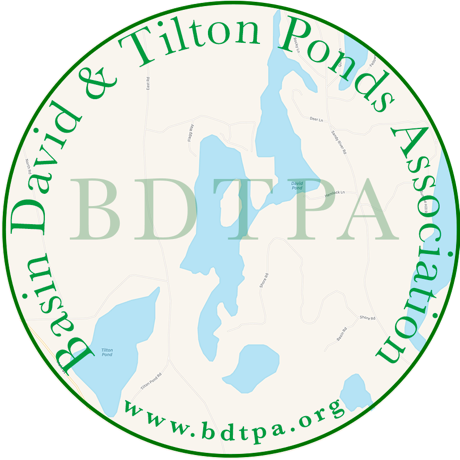Water Quality on David Pond
Deb Cayer
Our water quality data collection is done by the program director of the 30 Mile River Watershed association, Whitney Baker with the help of volunteers. It is summarized here.
For a complete and very informative report please check out 30mileriver.org click on "Our Impact", Water Quality Monitoring, and David and Basin ponds.
In 2021 our average clarity in David measured by Secchi disk (SDT) was 6.3m. With a period spanning 39 years and measurements in 17 of those years, our historical average clarity was 5.7m. The Maine lakes average is 4.8m.
Dissolved oxygen (DO) is a critical indicator of the health of the lake system. A good supply of oxygen in the water column is essential for fish and other aquatic species. Loss of oxygen may indicate a stressed and changing ecosystem. Severe oxygen loss (DO<2ppm, aka "anoxia") was documented in David in June at 11m and as the season progressed this zone of anoxic water grew to 7m and persisted through September. Understanding the pattern and extent of oxygen loss in deep waters is important to understanding changes between the years and throughout a single season, and is particularly concerning for David Pond because it may be more vulnerable to internal phosphorus loading due to its unique sediment chemistry.
Phosphorus is the nutrient that most influences the growth of algae in lakes. Small increases in phosphorus can cause substantial increases in algal growth. Nine samples were collected in 2021 between June and September. The range was 5ppb-8ppb with an average of 7ppb. Generally speaking, in-lake phosphorus concentrations (epilimnetic samples) less than 10-12 ppb are ideal. Lakes with in-lake phosphorus concentrations of 13 ppb or more are able to sustain algal blooms, and blooms become frequent as in-lake average concentrations approach 20 ppb. Historically, the annual average in-lake phosphorus concentration in David Pond has ranged from 6 ppb (1982, 2016, and 2017) to 10 ppb (2020) with a historical average annual concentration of 7 ppb.
Chlorophyll is found in plants including algae. This measurement done 5 times in 2021 is used to estimate the algae population in a lake. David's 2021 average was 4.4. Maine lakes average is 5,4.
10 years of consecutive data collection is needed to determine trends over time. The 30 mile program will continue to collect and analyze the data which will help our lake community address water quality concerns.
The next steps for the preservation of the water quality in David pond.
- To continue bi-weekly monitoring by the 30 mile May through September.
- To step up LakeSmart programming on David, providing education to shorefront owners about polluted stormwater runoff, phosphorus, and the effect tha development in the watershed can have on the water quality.
- Work with the 30 mile to review a list of priority sites identified in the 2011 watershed survey, and identify next steps.
Please take the time to fully understand the water quality data on the 30 mile site for both David and Basin ponds. Education is a powerful tool in taking action, and we all must take action to preserve the water quality in our ponds.
Please contact Deb Cayer (debbiecayer@gmail.com) for a lakesmart evaluation.
